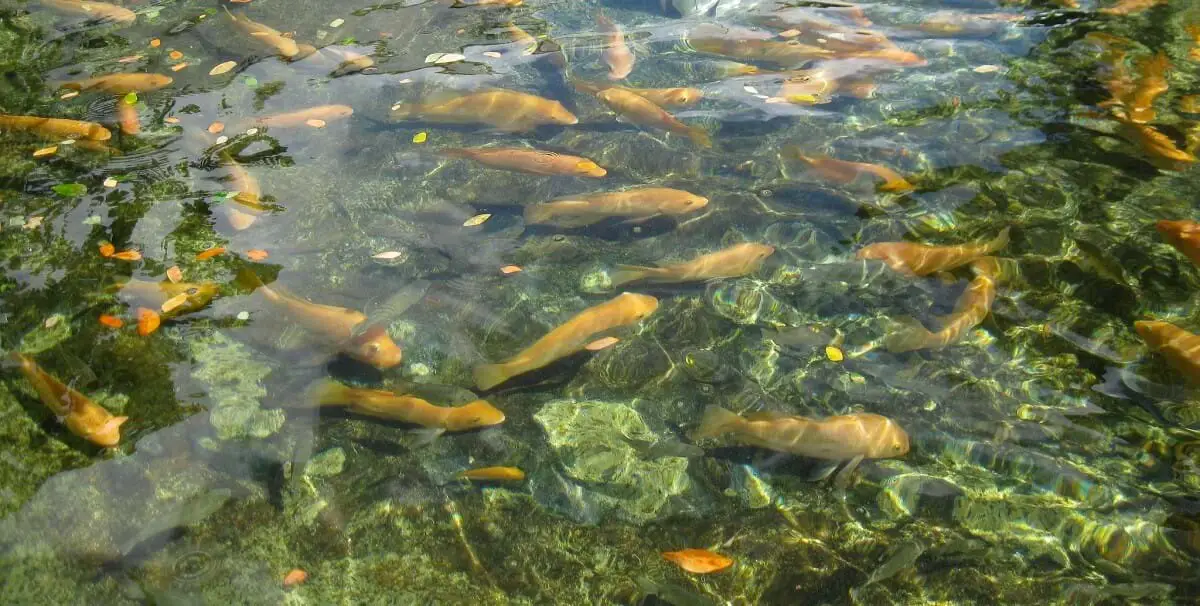Polyculture Fish Farming
What is Polyculture in Fish Farming

What is polyculture fish farming?
A polyculture fish farm is a practice of placing more than a single aquatic organism in the same water source.
Using a mixture of different fish species allows for better use of the available natural food produced in the water.
Fish polycultures most commonly get produced within ponds.
China has been using the practice of polyculture fish farming for over 4000 years.[4]
Fish production can get maximized when multiple species of fish with different feeding habits. Different feeding habits are important to ensure the species do not begin competing for resources with each other.
Depending on the depth of the pond, it can usually get divided into three different distinct zones.
The first is the upper zone, followed by the middle column and bottom zones.
The selected aquatic types will each exploit one of these zones for food.
For example, the catla is a surface feeder, Labeo rohita is a column feeder, and cirrhinus mrigala are bottom feeders.
How to Select Fish Species for Polyculture?
Selecting the correct species for your polyculture is the first important step.
You need to select a combination of fish with different feeding habits. It is common for some overlap of fish selection to happen.
We must make sure that we select a fish type for each level of our pond. You will need to select 1 species of fish that feed at one of the 3 levels.
The top layer of fish will be planktivorous. The middle level will use omnivorous to macro vegetation feeding fish species. Benthic/detritivorous for bottom feeding.
The most commonly used polyculture uses bighead, silver, and grass carp.
Other factors affecting the selection of fish and stocking rates are
- 1) Water temperature
- 2) Market value of fish
- 3) Pond fertilization practices
- 4) Feeding habits of fish
- 5) Tolerance to pond conditions
Polyculture Fish Farming Intensity
There are 3 different primary intensities of polyculture fish farming.
- 1) Extensive Culture
- 1) Semi-intensive Culture
- 1) Intensive Culture
Extensive Culture
In this system, the fish depend on their food source only from what is naturally available within the pond. No additional nutrients (manure and feed) are added by the farmer.
The lowest amount of fish production is achieved through this method but also has the lowest production costs.
Semi-intensive Culture
Semi-intensive culture systems work mainly by adding only manure to the pond. Supplementary feeding is minimal if used at all. While higher fish production is achieved because of a higher carrying capacity of the pond.
Farmers can fill the pond with a moderate stocking density but also have a higher production cost.
The fish food in the pond still relies mainly on natural food produced in the pond.
Intensive Culture
Fish production gets maximized when used under this system. Fish food is maximized by the use of high-quality formulated pellet feed.
Recirculation and aeration are also implemented to maintain a high water quality rich with oxygen.
While the production cost is higher, it also ensures the farmer can have a high stocking density giving the highest unit area production.
Advantages of Polyculture Fish Farming
- 1) Saving on resources
- 2) Higher profits are possible using a polyculture system. Having multiple species allows reduces the chance of profit loss.
- 3) Efficient polyculture systems in tropical climates may produce up to 8,000 kg of fish per hectare per year.
- 4) The natural productivity of the pond can get fully utilized.
- 5) Less risk of regression in water quality like dissolved oxygen depletion.
- 6) It can (but rarely does )allow for higher economic returns than monoculture under the same conditions.
- 7) It is better for the environment and is seen as a sustainable farming method.
Disadvantages of Polyculture Fish Farming
- 1) Control issues
- 2) You cannot maximize the inputs like you could when working with a monoculture setup.
- 3) Farmers need a higher understanding of how the different fish species interact.
- 4) Reduced control over size, age, and sex.
- 5) Harder to monitor.
Conclusion
Many people are also starting to move out and use more polyculture farming methods.
While monoculture fish farming was gaining popularity, the drawbacks associated with it have allowed polyculture farming to start growing in popularity.
Similar Articles
[1]https://cals.arizona.edu/azaqua/AquacultureTIES/publications/English%20WHAP/GT5%20Polyculture.pdf
[2]http://aquafind.com/articles/Polyculture.php
[3]https://aquaculture.ca.uky.edu/sites/aquaculture.ca.uky.edu/files/fish-polyculture.pdf
[4]https://link.springer.com/referenceworkentry/10.1007/978-1-4614-5797-8_176
[5]https://www.notesonzoology.com/india/fishery/polyculture-meaning-objectives-and-drawbacks/729
[6]https://ecolonomics.org/integrated-fish-farming-benefits-of-polyculture/
[7]https://www.todaysfarmedfish.org/top-5-ways-to-sustainably-farm-fish/no-1-polyculture-farming-multiple-species
[8]https://agrisujan.wordpress.com/2018/02/26/types-of-fish-culture-based-on-species-number-monoculture-and-polyculture/